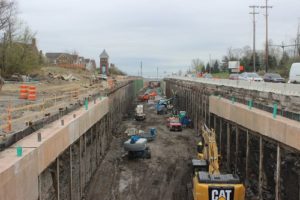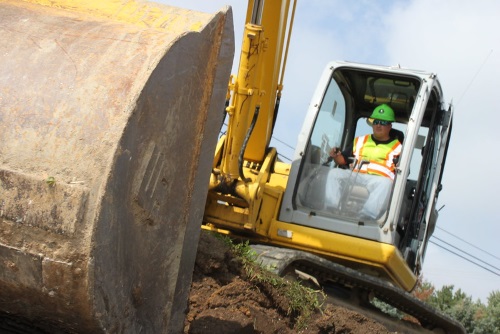Learning and working during the COVID-19 pandemic has made connectivity to the Internet more important than ever. That is why access to broadband service across the country is becoming essential for almost every communizing – providing critical virtual links to everything from online schooling to work-from-home opportunities. Those needs are not lost on the transportation industry.
[Photo courtesy of the Ohio DOT.]
That’s one reason why the Federal Highway Administration issued a notice of proposed rulemaking that would amend existing regulations governing the installation of broadband infrastructure on the right-of-way of Federal-aid or direct Federal highway projects.
According to the proposed rule, “highway rights-of-way are commonly used to accommodate public utilities, such as phone lines, electrical lines and pipelines. Expanding their use to include wireless broadband technology is a ‘critical next step’ in advancing connectivity in rural America.”
[Editor’s note: The FHWA is accepting comments on its proposed rule until September 14.]
Many state departments of transportation across the country are already participating in local efforts to improve and expand broadband access.
While states do not support a strict federal preemption on how states manage broadband deployment on their own properties, Carlos Braceras – executive director of the Utah Department of Transportation and the 2018-2019 president of the American Association of State Highway and Transportation Officials – noted in Congressional testimony that speeding up the federal permitting process would help facilitate “the merger of technology between motor vehicles and infrastructure.”

To that end, InnovateOhio – in partnership with the Ohio Department of Transportation – issued a 16-page broadband access report in September 2019 to provide a strategic plan for providing more broadband access to citizens and businesses. “Whether it’s connecting children to information at school or connecting smart vehicles to infrastructure, access to broadband is vital in the 21st Century,” said Jack Marchbanks, Ohio DOT’s director. “ODOT has always played a role in helping connect our state and this is just another opportunity to do that.”
That report highlighted that efforts to utilize right-of-way come with “special environmental” considerations. For example, the FHWA recommends the best practice of resource sharing in order to avoid repeated excavation. For instance, Dig Once initiatives have led to agreements between state DOTs and broadband contractors that allow use of right of way for fiber installation in exchange for broadband installation for highway message signs and autonomous and smart roadway transportation innovations. FHWA also encourages the use of trenchless technologies for broadband installation to minimize erosion and destruction of the area from construction.
When state DOTs need to issue permits for broadband installation on highway rights-of-way, categorical exclusions can typically be used when a request is for underground or above ground power, telephone, or pipelines, where no new structures, facilities, or major improvement to those facilities are required. Generally, buried communication lines fit this category.
As part of Ohio DOT’s strategic plan for broadband, the agency launched an E-Permitting System for right-of-way access that aims to be more convenient for permit requesters; especially in terms of saving time when requesting to install broadband fiber optic cable. This centralized, digital system replaces a paper-only right-of-way permitting system that the Ohio DOT managed across all 12 of its district offices.
[Details are available online at transportation.ohio.gov/permits.]
The agency also noted that partnerships in Ohio are fostering “environmental innovations” when increasing broadband installation in the right-of-way.
For instance, the City of Defiance proposed using sensors to monitor chemicals that can lead to harmful algal blooms in the local watershed. Yet those sensors needed a robust internet connection to allow researchers access to algal bloom data in real time. As a result, the city proposed installing concentric “fiber rings” connected to the monitoring stations via the existing infrastructure right-of-way – eventually expanding those fiber rings to provide high-speed internet services to residential and business customers.
That is an example of a right-of-way project that not only expanded broadband to underserved areas but also simultaneously helped solve real-world environmental problems, the Ohio DOT noted.

